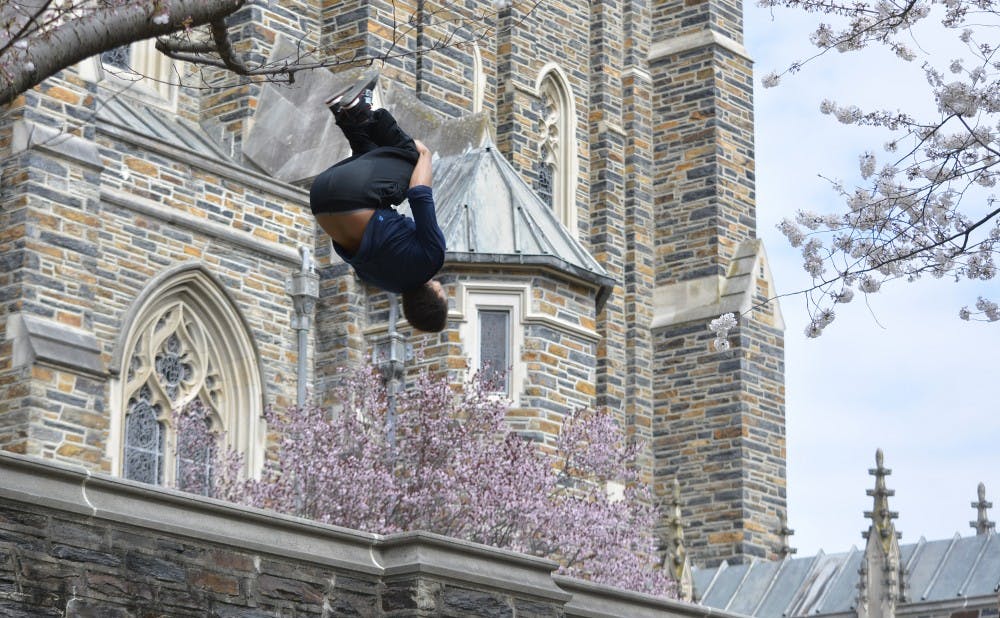Meet senior David Ivey—a sponsored Parkour athlete. Parkour athletes use only their own athleticism to get from point A to point B as efficiently as possible, which can include running, vaulting oneself off walls or swinging. Although it is usually done in urban locations, Parkour can be practiced anywhere, and athletes seek to see their environment and the art of navigation as constantly evolving. It began in the French military in the 1980s, and in the last 20 years it has become an increasingly popular recreational activity and competitive sport. The Chronicle's Amani Carson-Rose sat down with David to discuss balancing academics with Parkour.
The Chronicle: How did you get started?
David Ivey: Eight years ago I stumbled upon a Parkour video on YouTube. I was amazed by the guy’s ability to run, jump and flip, but I convinced myself that I could never do these things because I was overweight and unathletic. For six months I just let myself daydream about how cool it would be if I could do Parkour. I realized that what was stopping me wasn’t my body but my mind and what I was telling myself. I called up my friend and began trying out the easy movements we had seen in the videos.
TC: How did you get a sponsorship?
DI: I’m sponsored by American Parkour, which is based in Washington, D.C. I got to know the people running the company well, and I am very involved with organizing Parkour meet-ups there.
TC: How does Parkour fit into your life and busy schedule?
DI: Parkour is typically a big part of my life just because I enjoy doing it so much. It’s the first thing I want to do whenever I have free time. At this moment I have to fit my training time around school, which can be difficult to manage.
TC: How does being at college affect your training?

DI: My experience has been that college has not been conducive to my training. The workload can be pretty heavy which can really cut down on my time to train. The architecture, as beautiful as it is, doesn’t provide me with a lot of interesting areas to train, but the worst part is that there are very few people on campus who train. Not having a training partner at a similar level makes it hard to progress because I don’t have another set of eyes to discover new challenges and no one to help push me to train harder.
The saving grace for me was when I got to study abroad in Madrid last year. Madrid provided me everything for Parkour that Duke didn’t—a thriving community, amazing locations and enough time to have a life outside of work.
TC: How do you handle anxiety when doing Parkour?
DI: I think an important part of Parkour is accepting that I am human in that I can’t train until exhaustion every day. Some days I’m physically and mentally ready for the demands of the challenges I want to confront and others I’m not. Being able to identify and accept when I’m in the correct headspace and physically ready for trying new challenges and when I’m not is crucial.
If a challenge that I’m considering is making me extremely anxious I typically leave it alone, tackle similar challenges that help me prepare for the anxiety-inducing one and later I face it again once I’m ready. I also like figuring out and rehearsing how to react in case something goes wrong. After this preparation the most important thing to do is fully commit to whatever action I decide to take. Hesitation and self-doubt are normal reactions in the face of fear but the moment you take on a challenge you have to leave those things aside. Failing to trust yourself and not sticking with your plan is one of the easiest ways to get hurt.
TC: What about physical health and staying safe?
DI: The most important part to staying healthy is being smart while training and knowing what your body is capable of handling and what it can’t. As long as you practice good training habits—not trying challenges far beyond your skill level and giving your body time to recover after workouts—it isn’t especially hard to stay safe while training.
TC: What keeps you going?
DI: I enjoy how I feel while moving. Our bodies were made to move and they reward us when we let them do what they evolved to do. Also, overcoming my fears when I’m trying new challenges is an amazing feeling, as is watching your friends do the same.
TC: Have you faced, witnessed, or been made aware of discrimination within the Parkour community?
DI: I can’t speak entirely to that. What I can say is that I and most of the other practitioners of color that I have talked to have experienced discrimination but, as far as I know, only from people outside of the community. The most worrisome situation of this happens when dealing with the police. There are many stories about practitioners of color having guns drawn on them by aggressive police officers or being otherwise threatened. Until the police stop treating all people of color as criminals first and citizens second we’ll continue worrying about police brutality.
TC: How do you expect to be involved with Parkour after graduation?
DI: I’ll have a lot more time to focus on my training. Soon after graduation I’ll be going back for two months to do Parkour with a friend. I don’t plan on seriously pursuing Parkour professionally. My impression is that there aren’t enough opportunities offered to live entirely off Parkour. Beyond teaching or owning a gym it seems like the vast majority of pros have to work some other job to make ends meet.
Get The Chronicle straight to your inbox
Signup for our weekly newsletter. Cancel at any time.

